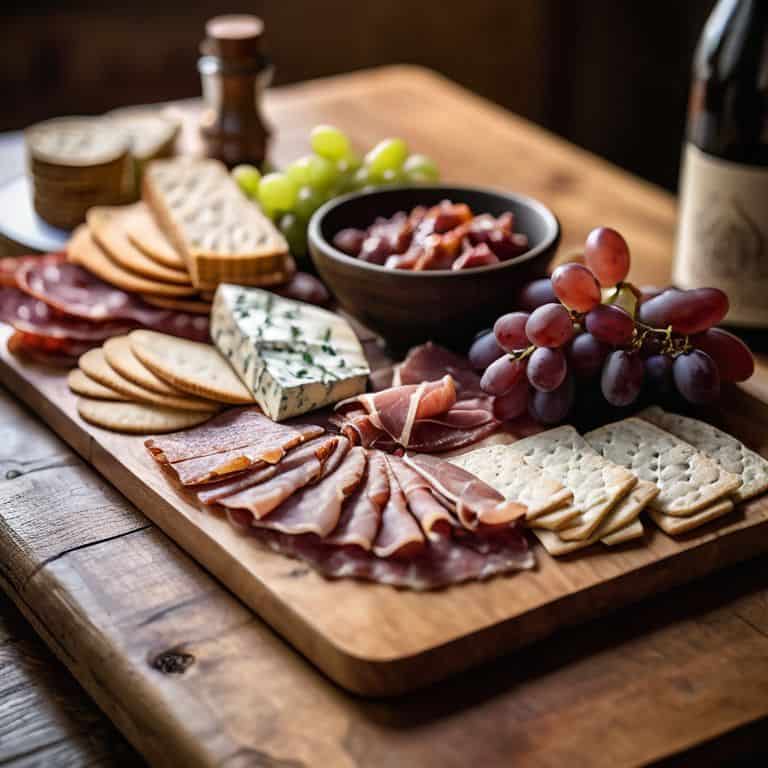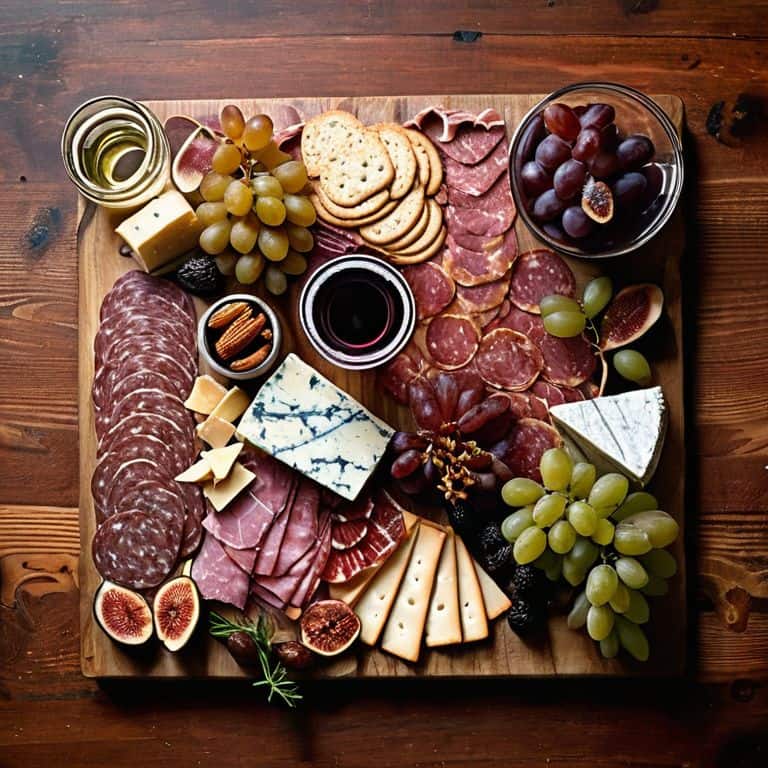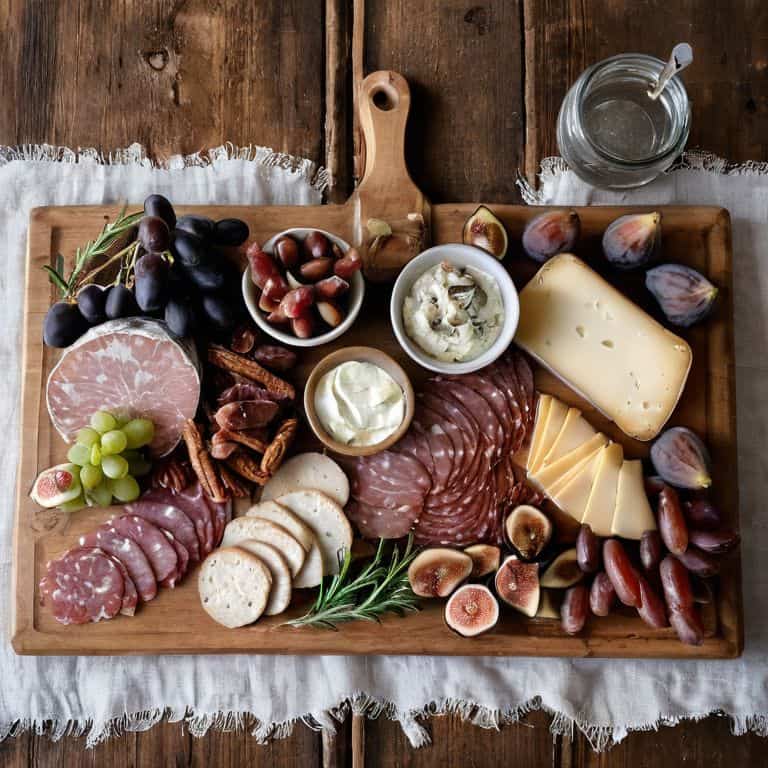I still remember the first time I stumbled upon a charcuterie board at a local market – it was love at first sight, and I was hooked on learning what is charcuterie and how to make a board. The vibrant colors, the variety of textures, and the explosion of flavors all combined to create an experience that was both familiar and excitingly new. As someone who’s passionate about experimenting with fresh ingredients and preserving techniques, I was fascinated by the idea of crafting my own charcuterie board from scratch. But what I’ve found is that many people are intimidated by the concept, thinking it’s only for special occasions or that it requires a lot of fancy ingredients.
As we dive into the world of charcuterie, I want to assure you that creating your own board is easier than you think, and it’s all about having fun with the process. In this article, I’ll share my personal tips and tricks for building an epic charcuterie board that’s perfect for any gathering. We’ll cover the basics of what makes a great charcuterie board, from selecting the perfect meats and cheeses to adding those extra special touches that will make your board truly unique. By the end of this guide, you’ll be equipped with the knowledge and confidence to create your own stunning charcuterie board that’s sure to impress your friends and family.
Table of Contents
- Guide Overview: What You'll Need
- Step-by-Step Instructions
- What Is Charcuterie
- Unleashing the Flavor: 5 Essential Tips for Crafting an Epic Charcuterie Board
- 3 Key Takeaways to Unleash Your Inner Charcuterie Rebel
- The Heart of Charcuterie
- Unleashing the Flavor Rebel: A Charcuterie Journey
- Frequently Asked Questions
Guide Overview: What You'll Need

Total Time: 1 hour 15 minutes
Estimated Cost: $50 – $100
Difficulty Level: Easy
Tools Required
- Cutting Board for assembling the charcuterie board
- Cheese Knife for slicing cheeses
- Meat Slicer optional, for slicing cured meats
Supplies & Materials
- Cured Meats such as prosciutto or salami
- Cheeses variety of soft and hard cheeses, e.g., brie, cheddar, gouda
- Crackers and Breads e.g., crostini, baguette slices, water crackers
- Fruits e.g., grapes, berries, sliced apples
- Nuts e.g., almonds, walnuts
- Spreads and Jams e.g., honey, mustard, chutney
- Garnishes e.g., fresh herbs, edible flowers, pomegranate seeds
Step-by-Step Instructions
- 1. First, let’s start with the basics: understanding what charcuterie is. It’s a French term that refers to a selection of cured meats, cheeses, and accompaniments, carefully chosen to provide a variety of flavors and textures. To begin, choose a few of your favorite cured meats, such as prosciutto or salami, and slice them into thin pieces.
- 2. Next, it’s time to think about the cheeses: a crucial component of any charcuterie board. Consider a mix of soft and hard cheeses, like brie and parmesan, and slice or crumble them into manageable pieces. Don’t be afraid to get a little creative with your cheese selection – the more variety, the better!
- 3. Now, let’s talk about accompaniments: the fun part. This is where you can get really creative and add some personal touches to your board. Consider adding some fresh fruits, like grapes or berries, as well as nuts, like almonds or walnuts. You can also add some chutneys or jams to provide a sweet and tangy contrast to the savory meats and cheeses.
- 4. Once you have all your ingredients, it’s time to start building your board. Begin by arranging your meats and cheeses in a visually appealing way – you can create a pattern or just go for a more free-form look. Don’t overcrowd the board, though: leave some space for your accompaniments and for your guests to graze.
- 5. Next, add your accompaniments to the board. Scatter your fresh fruits and nuts around the meats and cheeses, and spoon some chutney or jam into a small bowl or ramekin. Consider adding some fresh herbs, like rosemary or thyme, to add a fragrant and colorful touch to the board.
- 6. Now, it’s time to think about the presentation: how you want your board to look. Consider adding some garnishes, like pomegranate seeds or edible flowers, to add a pop of color and whimsy. You can also add some crackers or breadsticks to provide a base for building little charcuterie bites.
- 7. Finally, let’s talk about the finishing touches. Consider adding a few spreads, like hummus or mustard, to provide an extra layer of flavor. You can also add some pickled or marinated items, like artichoke hearts or pepperoncini, to add a tangy and salty element to the board. And don’t forget to have fun with it – the most important thing is to create a board that reflects your personality and style!
What Is Charcuterie

As I delve into the world of charcuterie, I’m reminded of the countless hours I spent behind the bar, experimenting with infusions and bitters. There’s something special about combining flavors and textures to create a truly unique experience. When it comes to charcuterie board ideas for parties, the key is to offer a variety of flavors and textures that will complement each other. I like to think of it as a flavor journey, where each bite takes you on a new adventure.
One of the most important aspects of building a charcuterie board is how to pair cheese and cured meats. It’s all about finding that perfect balance of salty, sweet, and tangy. I’ve found that a good rule of thumb is to start with a few core ingredients, like a rich cheese and a cured meat, and then add in some easy accompaniments like fresh fruit or nuts. This will help to create a sense of harmony on the board and make it easier for your guests to navigate.
As you start to build your charcuterie board, don’t be afraid to get creative and think outside the box. Consider seasonal charcuterie board inspiration and use ingredients that are fresh and locally sourced. This will not only add depth and complexity to your board, but it will also help to make it more unique and memorable. And remember, building a charcuterie board doesn’t have to break the bank – with a little bit of planning and creativity, you can create a stunning board on a budget.
Easy Diy Charcuterie Board
Now that we’ve explored the wonderful world of charcuterie, let’s talk about how to bring it all together with an easy DIY charcuterie board. For me, it’s all about having fun and being creative with the ingredients. I love mixing and matching different textures, colors, and flavors to create a visually stunning board that’s almost too pretty to eat.
I start by selecting a few of my favorite cured meats, like prosciutto or salami, and pairing them with an assortment of artisanal cheeses, crackers, and garnishes. Then, I add some fresh fruits, nuts, and pickled veggies to give it a pop of color and extra flavor. The key is to keep it simple, yet interesting, and to not be afraid to experiment with new combinations – after all, that’s what makes it fun!
Pairing Cheese and Cured Meats
Now that we’ve got a sense of what charcuterie is all about, let’s dive into the fun part – pairing cheese and cured meats. For me, this is where the magic happens. I love experimenting with different combinations to find that perfect balance of flavors and textures. A rich, creamy brie paired with a salty, crispy prosciutto is a match made in heaven, while a tangy goat cheese paired with a spicy chorizo can add a thrilling kick to your board.
When it comes to pairing, I say throw out the rulebook and trust your instincts. Try pairing a smooth, mild cheese like mozzarella with a more robust, savory meat like salami. Or, combine a pungent blue cheese with a sweet, cured ham. The key is to have fun and find the combinations that make your taste buds do the happy dance.
Unleashing the Flavor: 5 Essential Tips for Crafting an Epic Charcuterie Board
- Start with the Basics: Don’t be afraid to get creative, but make sure you’ve got a solid foundation of cured meats, cheeses, and crackers to build on
- Mix and Mingle: Combine different textures, flavors, and colors to create a visually stunning board that’s almost too pretty to eat
- Think Outside the Box: Don’t limit yourself to traditional charcuterie items – add some unexpected elements like fresh fruits, nuts, or pickled veggies to give your board some personality
- Balance is Key: Make sure your board has a mix of salty, sweet, tangy, and umami flavors to keep things interesting and prevent palate fatigue
- Get Your Hands Dirty: Remember, the most important ingredient in any charcuterie board is love – so don’t be afraid to get a little messy and have fun with the process!
3 Key Takeaways to Unleash Your Inner Charcuterie Rebel
Get creative and experiment with different combinations of cured meats, cheeses, and accompaniments to find your perfect charcuterie board flavor profile
Remember, the art of charcuterie is all about balance and harmony – mix and match textures, colors, and flavors to create a visually stunning and delicious spread
Don’t be afraid to get a little messy and add your own personal touch to your charcuterie board – whether it’s a homemade chutney or a freshly baked baguette, the most important ingredient is love and a willingness to have fun
The Heart of Charcuterie
Charcuterie is more than just a fancy board of meats and cheeses – it’s about crafting a story with each bite, where every flavor and texture comes together in perfect harmony, and the best part is, you get to be the author of that story, one delicious piece at a time.
Tom Navarro
Unleashing the Flavor Rebel: A Charcuterie Journey

As we’ve explored the world of charcuterie, from understanding its rich history to learning how to craft the perfect board, it’s clear that the art of combining cured meats, cheeses, and accompaniments is all about balance and creativity. We’ve delved into the basics of pairing cheese and cured meats, discovered the simplicity of creating an easy DIY charcuterie board, and touched on the importance of using high-quality, local ingredients. Whether you’re a seasoned foodie or just starting your culinary journey, the key takeaway is that charcuterie is an incredibly versatile and personal experience.
So, as you embark on your own charcuterie adventures, remember that it’s not just about the food – it’s about the story behind each item, the love that goes into preparing it, and the joy of sharing it with others. Don’t be afraid to experiment, to try new combinations, and to make mistakes. For in the world of charcuterie, as in life, it’s the journey, not the destination, that truly matters. With every board you create, you’re not just serving food – you’re serving a piece of yourself, and that’s what makes it truly special.
Frequently Asked Questions
What are some essential items to include on a charcuterie board for a beginner?
For a beginner’s charcuterie board, I say keep it simple and delicious. You’ll want a mix of creamy cheeses, cured meats like prosciutto or salami, some crusty bread, and a few pickled or fresh goodies like grapes or figs. Don’t forget a few nuts and some spreads like honey or mustard to bring it all together!
How do I know which cheeses and cured meats will pair well together?
Ah, the million-dollar question! For me, it’s all about feeling the flavors. I like to think about what grows together, goes together. Try pairing cheeses and meats from the same region, like a rich brie with a French jambon. Or, mix and match textures and tastes, like creamy gouda with crispy prosciutto. Trust your instincts, and don’t be afraid to experiment!
Can I customize my charcuterie board with unique or homemade items, such as pickled vegetables or infused jams?
Absolutely, my friend! I’m all about getting creative with homemade goodies. Pickled veggies, infused jams, or even my famous spicy pickles can add a whole new level of flavor to your charcuterie board. Experiment with different combinations to find your perfect mix – the more unique, the better, I say!
